Themed collection Lab on a Chip Pioneers of Miniaturization Lectureship winners

Interdigitated microelectronic bandage augments hemostasis and clot formation at low applied voltage in vitro and in vivo
An interdigitated microelectronic device that applies low voltage (<9 V) electrical field augments hemostasis in vitro and in vivo.
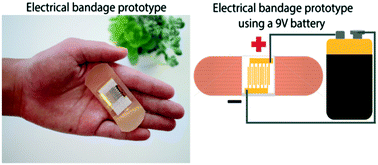
Lab Chip, 2018,18, 2985-2993
https://doi.org/10.1039/C8LC00573G
On-chip functional neuroimaging with mechanical stimulation in Caenorhabditis elegans larvae for studying development and neural circuits
New designs of microfluidic devices can facilitate recording of C. elegans larvae neuronal responses to precise mechanical stimuli, which reveal new understanding of development of mechanosensory neurons and circuits.

Lab Chip, 2018,18, 601-609
https://doi.org/10.1039/C7LC01201B
Probing blood cell mechanics of hematologic processes at the single micron level
Single-micron PDMS devices provide insight into the biophysical effects that vascular matrices have on platelets, RBCs, and neutrophils.

Lab Chip, 2017,17, 3804-3816
https://doi.org/10.1039/C7LC00720E
Biophysical isolation and identification of circulating tumor cells
The integrated vortex enrichment–deformability cytometry device may enable automated enumeration of circulating tumor cells from blood by mechanophenotyping.
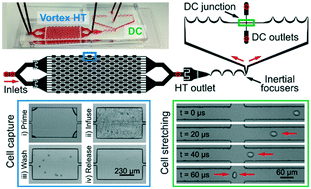
Lab Chip, 2017,17, 1452-1461
https://doi.org/10.1039/C7LC00038C
A vascularized and perfused organ-on-a-chip platform for large-scale drug screening applications
A vascularized, perfused organ-on-a-chip platform suitable for large-scale drug efficacy/toxicity screening.
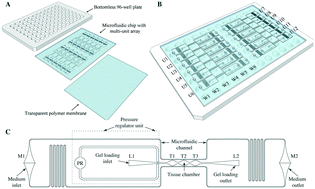
Lab Chip, 2017,17, 511-520
https://doi.org/10.1039/C6LC01422D
An inkjet printed, roll-coated digital microfluidic device for inexpensive, miniaturized diagnostic assays
Inkjet printing is combined with roll-coating to fabricate digital microfluidic (DMF) devices outside of the cleanroom for inexpensive, miniaturized diagnostic assays, with straightforward scalability towards mass production.
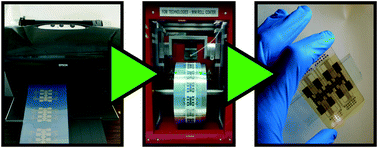
Lab Chip, 2016,16, 4560-4568
https://doi.org/10.1039/C6LC01064D
Bioprinted thrombosis-on-a-chip
A novel bioprinted model of thrombosis was developed to study thrombosis and thrombolysis in vitro.

Lab Chip, 2016,16, 4097-4105
https://doi.org/10.1039/C6LC00380J
Engineering a perfusable 3D human liver platform from iPS cells
The authors present a human liver model that supports both primary hepatocytes and human iHeps with flexibility for systems integration.
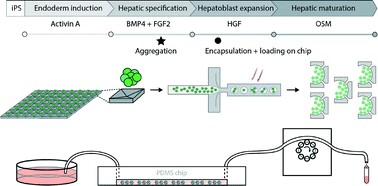
Lab Chip, 2016,16, 2644-2653
https://doi.org/10.1039/C6LC00598E
Wash-free magnetic immunoassay of the PSA cancer marker using SERS and droplet microfluidics
We report a novel wash-free magnetic immunoassay technique for prostate-specific antigen that uses a surface-enhanced Raman scattering-based microdroplet sensor.
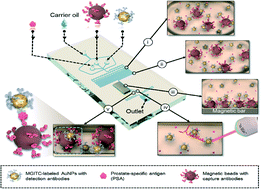
Lab Chip, 2016,16, 1022-1029
https://doi.org/10.1039/C5LC01249J
Surface-tension driven open microfluidic platform for hanging droplet culture
A hanging droplet culture platform enabling culture of shear-sensitive and suspension cells with a high degree of accessibility to culture.

Lab Chip, 2016,16, 334-344
https://doi.org/10.1039/C5LC01353D
A cost-effective fluorescence mini-microscope for biomedical applications
A miniature microscope was designed and fabricated with built-in fluorescence capability for biomedical applications.

Lab Chip, 2015,15, 3661-3669
https://doi.org/10.1039/C5LC00666J
Photopatterned oil-reservoir micromodels with tailored wetting properties
We present a new method to fabricate oil-reservoir micromodels with heterogeneous wetting properties.
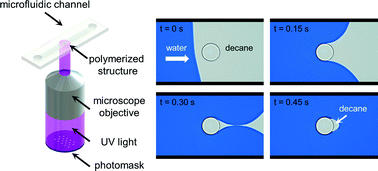
Lab Chip, 2015,15, 3047-3055
https://doi.org/10.1039/C5LC00277J
Whole blood human neutrophil trafficking in a microfluidic model of infection and inflammation
Inflammation on a chip.
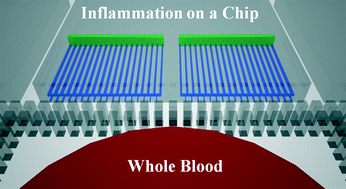
Lab Chip, 2015,15, 2625-2633
https://doi.org/10.1039/C5LC00245A
Microfluidic cellular enrichment and separation through differences in viscoelastic deformation
We report a microfluidic approach to separate and enrich a mixture of two cell types based on differences in cell viscoelastic behavior during repeated compressions and relaxation events.
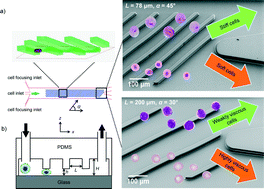
Lab Chip, 2015,15, 532-540
https://doi.org/10.1039/C4LC01150C
Microfluidic serial digital to analog pressure converter for arbitrary pressure generation and contamination-free flow control
Microfluidic serial digital to analog pressure converter can generate arbitrary analog pressures on-chip for real time, automated flow control.
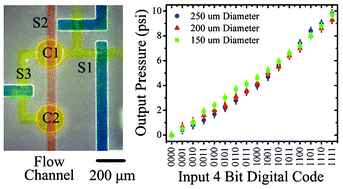
Lab Chip, 2013,13, 1911-1918
https://doi.org/10.1039/C3LC41394B
Rapid antibiotic susceptibility testing by tracking single cell growth in a microfluidic agarose channel system
We demonstrate a microfluidic agarose channel system that uses agarose as a fixation material of bacteria and reduces the time taken for antibiotic susceptibility testing.

Lab Chip, 2013,13, 280-287
https://doi.org/10.1039/C2LC41055A
Immuno-pillar chip: a new platform for rapid and easy-to-use immunoassay
We present a new rapid and easy-to-use immunoassay chip which we have named the immuno-pillar chip. It has hydrogel pillars, fabricated inside a microchannel, with many antibody molecules immobilized onto 1 µm diameter polystyrene beads.
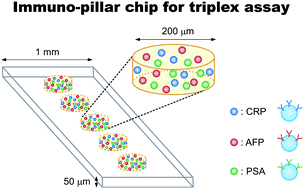
Lab Chip, 2010,10, 3335-3340
https://doi.org/10.1039/C0LC00241K
Analyzing cell mechanics in hematologic diseases with microfluidic biophysical flow cytometry
Measurement of blood cell mechanics is enabled by flowing cells through a parallel network of microchannels. Here, an acute myeloid leukemia cell from a patient who died of leukostasis, a complication of acute leukemia, occludes a microchannel, mimicking in vivo microvascular occlusion.
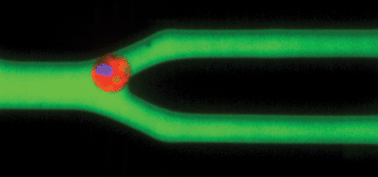
Lab Chip, 2008,8, 1062-1070
https://doi.org/10.1039/B802931H
3D microvascular model recapitulates the diffuse large B-cell lymphoma tumor microenvironment in vitro
This 3D multiplex in vitro microvascular model of the DLBCL microenvironment incorporates an endothelialized microvessel traversing a hydrogel-based tumor model.

Lab Chip, 2017,17, 407-414
https://doi.org/10.1039/C6LC01204C
About this collection
This collection contains papers authored by winners of the Lab on a Chip Pioneers of Miniaturization Lectureship. Nominations for the Lectureship open in spring each year and the winner is announced in late summer. The winner gives a lecture at the annual MicroTAS conference.
2020 winner: Professor Wilbur Lam, Georgia Institute of Technology/Emory University, USA
Professor Lam is a physician-scientist-engineer and clinical pediatric hematologist/oncologist. He is the W. Paul Bowers Research Chair of Pediatrics and Biomedical Engineering at Emory University and Georgia Tech and an attending physician at the Aflac Cancer and Blood Disorders Center of the Children’s Healthcare of Atlanta.
His laboratory focuses on developing microsystems to study and diagnose hematologic diseases including sickle cell disease, thrombotic/bleeding disorders, and leukemia. He is also principal investigator of the Atlanta Center for Microsystems Engineered Point-of-Care Technology (ACME POCT), an integral part of the NIH’s Point-of-Care Technologies Research Network (POCTRN) and RADx COVID-19 initiative.
Professor Lam received his MD from Baylor College of Medicine, going on to earn his PhD in Bioengineering from the University of California, Berkley. He completed his Fellowship in Pediatric Hematology/Oncology and Residency in Pediatrics at the University of California, San Francisco.
Learn about the Lam lab online.
Previous winners of the Pioneers of Miniaturization Lectureship
2019: Professor Hang Lu, Georgia Tech, USA
2018: Professor Sunghoon Kwon, Seoul National University, South Korea
2017: Professor Aaron Wheeler, University of Toronto, Canada
2016: Professor Daniel Irimia, Massachusetts General Hospital, USA
2015: Professor Dino Di Carlo, University of California, Los Angeles, USA
2014: Professor Sangeeta N. Bhatia, Massachusetts Institute of Technology, USA
2013: Professor Shuichi Takayama, University of Michigan, USA
2012: Professor Andrew deMello, ETH Zürich, Switzerland
2011: Professor Ali Khademhosseini, Massachusetts Institute of Technology, USA
2010: Professor Stephen Quake, Stanford University, USA
2009: Professor Abe Lee, University of California, Irvine, USA
2008: Dr Patrick Doyle, Massachusetts Institute of Technology, USA
2007: Dr Manabu Tokeshi, Nagoya University, Japan
2006: Dr David Beebe, University of Wisconsin, USA